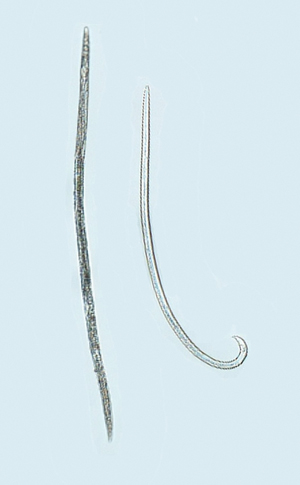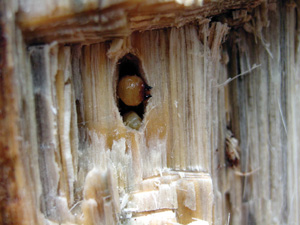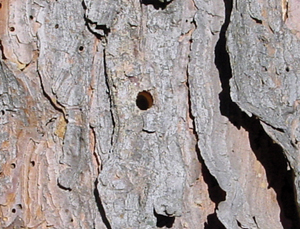G1899
Pine Wilt in Nebraska
Pine wilt, a disease spread by the pinewood nematode, kills mature Scotch pines. If identified early, the disease often can be prevented from spreading.
Amy D. Ziems, Extension Educator — Plant Pathology
Mark O. Harrell, Forest Health Specialist
Introduction
Pines are an important component of many urban and rural landscapes in Nebraska. Since 2000, a disease called pine wilt has killed many mature Scotch (Scots) pine (Pinus sylvestris) throughout the state. Pine wilt is caused by the pinewood nematode, Bursaphelenchus xylophilus, a microscopic (1 mm long) worm, which is moved from infested to noninfested pine trees by the pine sawyer beetle (Monochamus spp.)
Symptoms
Pine wilt typically kills Scotch pine within a few weeks to a few months (Figure 1-3) after the pine sawyer beetle introduces the nematode to the tree. Initially the needles turn grayish green (Figure 1), then tan (Figure 2) and finally brown (Figure 3). The resin flow in the symptomatic branches ceases as the tree declines, giving the wood a dry appearance and feeling, lacking the typical stickiness when cut. Needles remain attached to the dead tree for a year or more. Scattered branches on a tree may be affected initially (Figure 1), but the problem soon spreads to the remaining branches (Figure 3). At other times, the entire tree turns brown all at once.
 |
 |
 |
||
| Figure 1. Scotch pine showing scattered browning of branches taken August 20. Photo courtesy of Laurie Stepanek, Nebraska Forest Service. | Figure 2. Scotch pine showing progression of branches browning due to pine wilt infection, August 25. Photo courtesy of Laurie Stepanek, Nebraska Forest Service. | Figure 3. Scotch pine killed by pine wilt, September 2. Photo courtesy of Laurie Stepanek, Nebraska Forest Service. |
Host Range
The majority of trees killed in the Midwest by pine wilt have been Scotch pine. However, there are other pine species that are occasionally killed and display a similar pattern of symptoms. The disease has appeared in Austrian (Pinus nigra), jack (P. banksiana) and mugo (P. mugo) pines and rarely in white pine (P. storbus). In ponderosa pine (P. ponderosa), the pinewood nematode has been identified, but it has not been known to kill the tree. Native pine species generally show more resistance to the disease than species not native to North America.
Disease Cycle
There are several organisms involved in the pine wilt disease cycle. The pinewood nematode (Figure 4) initially feeds on the living plant cells that surround the resin canals and water conducting passages. Later, after blue-stain fungi (Ceratocystis spp.) (Figure 5) are brought to the dying tree by bark beetles, the nematodes feed on the fungi and grow and reproduce more rapidly.
 |
 |
|
| Figure 4. Microscopic (50x magnification) view a female (left) and male (right) pinewood nematode. | Figure 5. Sectors of cobalt-blue discoloration in a Scotch pine, caused by blue-stain fungi. |
The nematodes are unable to move from tree to tree without the help of their insect vector, the pine sawyer beetle (Monochamus spp.) (Figure 6), also known as a longhorned beetle due to its very long antennae. The female beetles lay their eggs under the bark of dead or dying pine trees during the summer months. The larvae hatch and begin to feed under the bark (Figure 7) and eventually tunnel deeper into the wood to form a pupal chamber where the larvae pupate and later become adults (Figure 8). Adult beetles are 3/4 to 1 1/2 inches in length (not including antennae) and emerge any time from May to September (Figure 9).
 |
 |
|
| Figure 6. Adult pine sawyer beetle. | Figure 7. Feeding damage from pine sawyer larvae under the bark. | |
 |
 |
|
| Figure 8. Pine sawyer larva in its pupal chamber. | Figure 9. Pine sawyer beetle exit hole. |
Beetle larvae and nematodes grow and mature simultaneously with each other. When the adult beetles emerge from their pupae stage, the pinewood nematode larvae move from the wood into the breathing tubes of the emerging beetles. As the beetles tunnel to the surface of the tree and fly away, each can carry up to tens of thousands of nematodes.
The adult beetles are able to fly several miles to find another stressed pine where they feed on young twigs. The feeding that is done by the beetles does little damage to the tree, however the feeding sites create points of entry for the pinewood nematode. The nematodes leave the adult beetles and migrate to the feeding sites and enter the tree.
If the nematodes enter a resistant pine species, the nematodes soon die and no disease develops. When the nematodes enter a susceptible pine, they move to the water-conducting passages where the juvenile nematodes molt into the adult stage. The adults begin to feed on the living cells surrounding the passages and the resin canals. During the summer months, the nematodes move throughout the tree and multiply rapidly. As the nematodes move throughout the tree, they continue feeding and disrupt the movement of water which results in the development of the wilt symptom and decline of the tree.
The age of the tree influences its risk of pine wilt. The majority of the reported cases of pine wilt have been in trees more than 10 years old. Pine wilt typically does not have a major impact on Christmas tree plantations of Scotch pine, since most of the trees are harvested before 10 years of age. The primary impact of this disease has been in landscape plantings and windbreaks.
How to Sample for Pinewood Nematode
When a pine dies suddenly, especially a Scotch pine, pine wilt is a leading suspect. Properly identifying pine wilt is important in areas where the disease is not yet common in order to prevent the movement of the nematode to nearby healthy trees. If proper actions are not taken, an entire windbreak or planting can be lost within a few years. In areas where pine wilt is already common, all Scotch pines that die should be removed and disposed of quickly, because whether they died from pine wilt or not, they can serve as sources of the beetles and nematodes.
To confirm the presence of the pinewood nematode in a dead or dying pine, it is necessary to extract the nematode from the wood. A wood sample should be taken from the lower trunk or the base of large lower limbs. Alternatively, a disk of wood, 3-4 inches in length can be taken from a branch a minimum of 3 inches in diameter near the trunk. Samples should be placed in a plastic bag and kept cool. Samples should be quickly shipped or delivered to:
Plant and Pest Diagnostic Clinic
University of Nebraska–Lincoln
448 Plant Science Hall
P.O. Box 830722
Lincoln, NE 68583-0722
Phone: (402) 472-2559
For more information regarding sample submission visit: www.pdc.unl.edu/diagnosticclnics/plantandpest.
Once the sample arrives at the diagnostic clinic, the wood is cut into small chips and submerged in water, which forces the nematodes out of the wood. The nematodes are collected from the water and examined under a compound microscope. The pinewood nematode is identified by the presence of distinctively thorn-shaped spicules in the posterior end of the male nematode (Figure 10) and the vulva flap in the posterior end of the female nematode (Figure 11) as well as by other morphological characteristics. Careful microscopic examination of the nematodes is needed to prevent misidentification of pinewood nematode infection. There are several other nematode species that reside in trees that do not cause any disease.
 |
 |
|
| Figure 10. Male pinewood nematode with the characteristic rose-thorn shaped spicule (200x magnification). | Figure 11. Female pinewood nematode with the characteristic vulval flap (200x magnification). |
Management
Sanitation is the most important management practice to prevent or slow the spread of pine wilt. To reduce the amount of spread to healthy trees, diseased trees and any Scotch pines that die in areas where pine wilt is common, whether from pine wilt or not, must be removed and destroyed before pine sawyer beetles emerge from the trees. Even trees that have not died from pine wilt can have the nematode brought to them and become a source of beetles spreading the nematodes. Trees dying between May 1 and October 1 should be cut down promptly and burned, buried, or chipped. Do not hold the wood for firewood because the beetles can still emerge from the wood. When trees are identified after October 1, the trees do not need to be removed immediately because the beetles are not active during the winter months, however, they must be removed and destroyed by the end of April.
High value pines can be protected to some degree with trunk injections of the insecticide/nematicide abamectin. One application provides about 70 percent protection each year for about three years. The treatment is available from professional arborists.
When replacing pines that have been killed due to pine wilt, it is recommended not to replant with a Scotch pine due to their high susceptibility to pine wilt. Austrian pines also can be killed by pine wilt and these trees are extremely susceptible to two fungal diseases: Diplodia tip blight and Dothistroma needle blight. Spruces, firs, red cedar, junipers, and white and ponderosa pine face little threat from pine wilt.
This publication has been peer reviewed.
Visit the University of Nebraska–Lincoln Extension Publications Web site for more publications.
Index: Plant Diseases
Trees
Issued October 2008